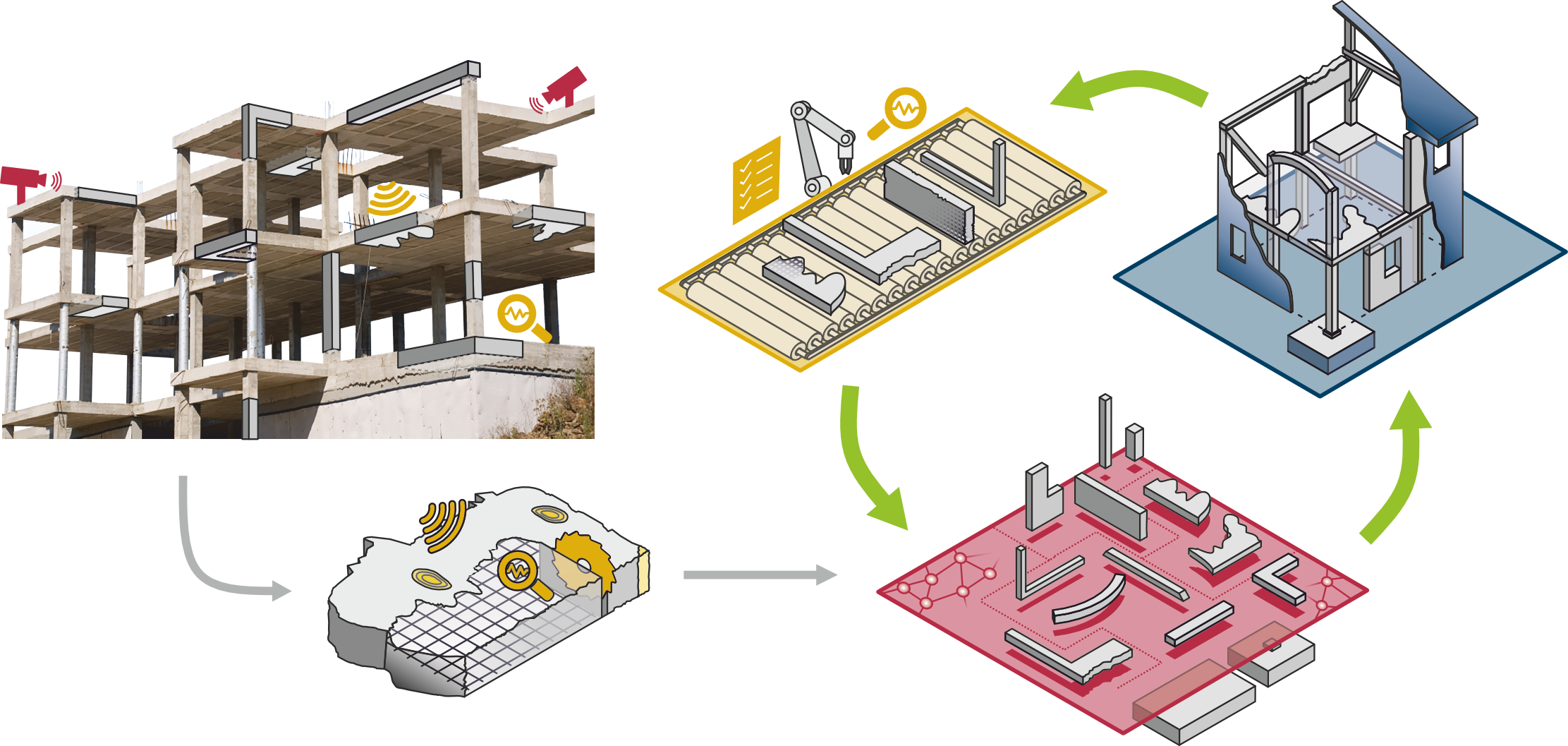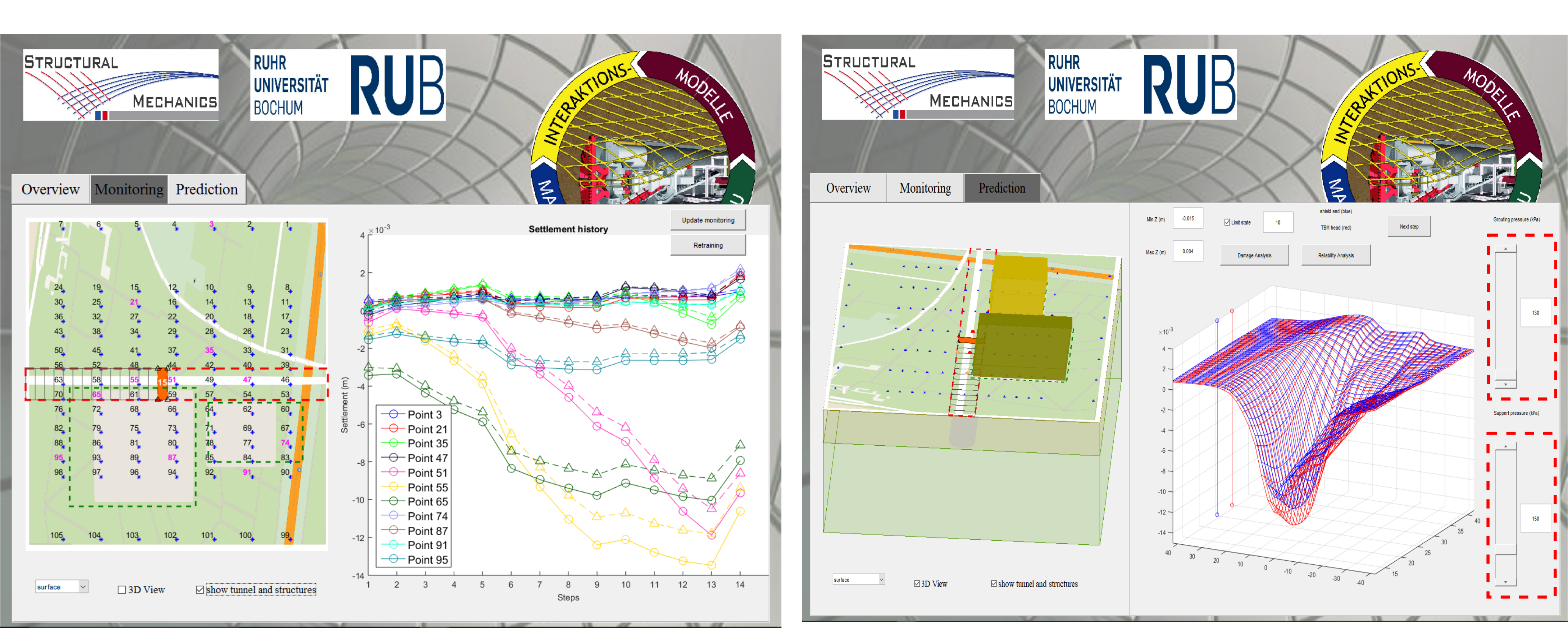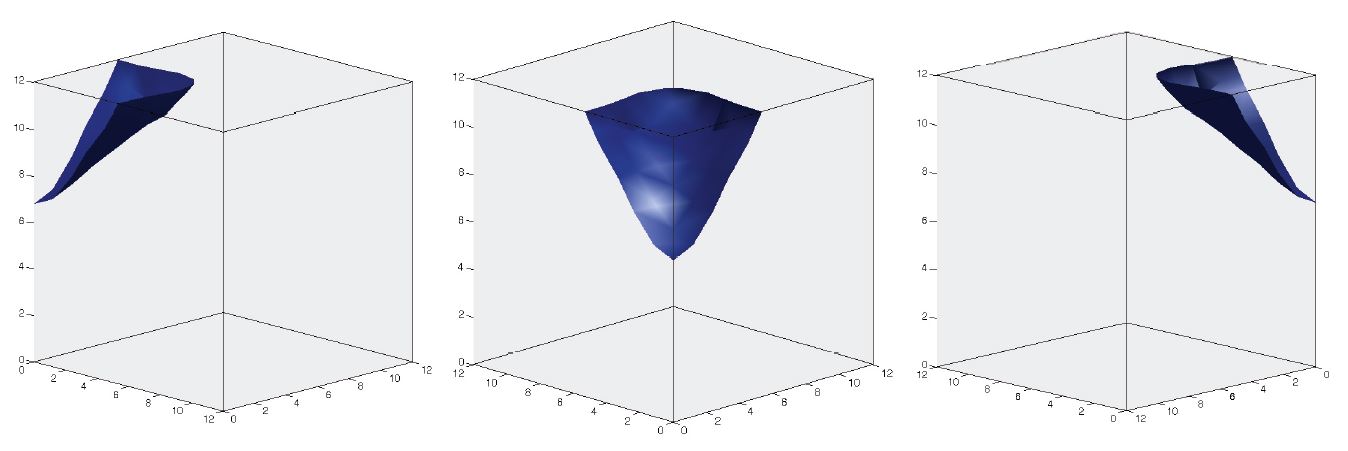The Institute for Structural Mechanics develops numerical models for simulations of short and long-term behavior of materials and structures. The objective is to enable reliable predictions of structural damage and degradation as well as the structural lifetime. The research on material and structural models is focused on scale bridging approaches to consider the interactions between the micro structure of materials and the macroscopic structural behavior. Current research is also related to surrogate modeling for simulations with uncertain data and the fusion of numerical simulations and monitoring data for process steering.

Instead of recycling old concrete, researchers of the SFB 1683 will investigate existing concrete elements, e.g. ceilings, walls, supports and foundations, regarding their quality, reusability and adaptability. All these information will be gathered to build a modular construction kit, which in turn will give the base to build up a building from recently produced and adapted old structures.
This innovative concept aims to reduce greenhouse gas emissions and curb the accumulation of unmanageable masses of construction waste.
The Institute for Structural Mechanics is involved with two sub-projects in this research:
A02 - Simulation methods for modular connections of reused concrete elements
This project focuses on the development of numerical methods for the modelling and digital design of joints of reused concrete modules. Design optimisation algorithms based on robust mathematical formulations are developed considering several aims, such as minimising the added material, minimising costs and manufacturing emissions, and maximising strength and durability. It is also crucial to develop reliable simulation models that can accurately describe the mechanical behaviour of the joints, taking into account contact stress, prestressing and concrete damage.
A05 - Reliability-based structural performance assessment considering polymorphic uncertainties of reused concrete elements
The aim of this subproject A05 is to develop concepts for determining and ensuring the reliability of structures made of reused concrete elements. The consistent consideration of uncertainties at the concrete element level and at the structural level in combination with dedicated nonlinear computational models allows to realistically investigate the structural performance during the intended service life under consideration of ageing and the environmental impact.
More information at
SFB 1683

The aim of the research project is to gain insights into the interaction of binder-specific dehydration mechanisms of hardened cement paste, the microcrack network that forms and its changes during the fire exposure of concrete, and the resulting thermo-hydraulic transport processes. For this purpose, a combination of multiphysical models is developed to predict the chemo-hydro-thermo-mechanical behavior of the examined blended concretes, with sub-models characterizing the damage and transport processes at several spatial scales.
More information at
DFG GEPRIS - Project number 491928256
Through their research, this project group led by Prof. Gehlen (Technical University of Munich) aims to establish a model-based characterization of the degradation of concrete on multiple scales and enable a classification of the degree of damage based on simulated and measured coda data. The role of the institute of Structural Mechanics within this Research Unit is the characterization of the influence of the changes in the structure (microscale and macroscale) of concrete subject to various loading scenarios and the application of novel pattern recognition algorithms for the identification and classification of CODA signals.
More information at
CODA.

In 2010, the German Research Foundation (DFG) has established the Collaborative Research Center SFB 837 "Interaction Modeling in Mechanized Tunneling" at Ruhr University Bochum. After 12 years of research, the 16 sub-projects ended at the end of 2022 after the 3rd funding phase. However, two new transfer projects have been established within the SFB 837, one of those is supervised by the Institute for Structural Mechanics:
- T2: Simulation-and-Monitoring-Based Real-Time Steering in Mechanized Tunneling
More information at
SFB 837.
In subproject "Influence of Microfibers on the Degradation of High Performance Concrete under Cyclic Loading" of the DFG-Priority Program 2020, numerical models are developed to resolve the microcracks of high-performance concrete at the mesoscale level allowing to follow their evolution along the complete loading history. A central question is to what extent the development of microcracks (a few µm in width, 1 - 1.5 mm in length) can be influenced by microfibers and how different types of microfibers affect the microcrack development.
More informationen at
SPP 2020.
The objective of subproject 6 “Optimization Approaches for Robust and Durable Reinforced Concrete and Fibre Concrete Structures under Consideration of Scale Bridging Polymorphic Uncertainty Modelling“ of the DFG-Priority Program SPP 1886 is the development of computational reliability and optimization methods for the lifetime oriented design of reinforced and steel fibre concrete structures, which allow to follow the influence of uncertain, i.e. non-deterministic describable design parameters and uncertain time variant structural actions on the structural state throughout its life. Thereby, interactions between loading induced damage and environmentally induced deterioration processes are considered by multiscale models in conjunction with physically sound durability models. The structural reliability is computed by multifield simulations under consideration of polymorphic uncertain data (stochastic parameters, intervals and fuzzy numbers as well as generalized uncertainty models).
More informationen at
SPP 1886 TP 6.
The DFG-Priority Program SPP 1886 was coordinated by Prof. Kaliske at TU Dresden. Prof. Meschke and Prof. Freitag were responsible for Complex C „Interactions and Multi-Physical Behavior Considering Uncertain Data“ of SPP 1886.
The goal of subproject 3 "Computational Modelling of Alkali Transport and ASR-induced Damage in Concrete" of the DFG-Research Unit FOR 1498 is the development of a computational model to predict ASR induced damage in concrete structures, specifically in concrete pavements for various environmental conditions, conditions of degradation and types of concrete mixture. A multi-scale strategy based on continuum micromechanics for transport of pore-fluid and alkali in intact and pre-damaged concrete is developed and implemented within the framework of a multiphase finite element method. The model has the capability to take into account the interactions of diffuse microcracks and the cement matrix.
More informationen at
FOR 1498 - AKR.
Within the university alliance UA Ruhr, the Institute for Structural Mechanics at Ruhr University Bochum is cooperating with the Institute for Artificial Intelligence at TU Dortmund within the research project “Fusion of Machine Learning and Numerical Simulation for Real-Time Steering in Mechanized Tunneling” The project is funded by the Mercator Research Center Ruhr (MERCUR). The objective is to link simulation and monitoring based approaches for real-time predictions of mechanized tunneling processes with machine learning methods. The physics of the underlying processes obtained by simulation models are fused with knowledge gained from real-time data analyses of monitoring and sensor data to improve the process steering in mechanized tunneling.
More informationen at
MERCUR.
Hydraulic fracturing is a method to increase the hydraulic conductivity of low-permeable rock formations in order to extract oil and gas from deep underground reservoirs. The Institute for Structural Mechanics was involved in three subprojects of the Shynergie project.
UP 1 “Experimental investigation and hydro-mechanical modeling of the propagation mechanisms of stimulation-induced fractures”
The aim of the subproject (UP1) was to develop numerical methods for the simulation and analysis of hydraulic stimulation scenarios in 2D- and 3D-settings. Assuming the brittle behavior of rocks, the research focused primarily on the Griffith's theory of cracks equilibrium. Two different models have been developed based on the variational approach to the fracture mechanics and the theory of configurational forces.
UP 5 “Scale bridging modelling of inelastic processes of hydraulic stimulation”
The information on the influence of induced and pre-existing fractures on the overall permeability and diffusivity of subsurface energy reservoirs is one of the fundamental quantities in engineering energy extraction systems. Using a multiscale micromechanics modelling approach, a simple explicit formulae has been developed for estimating the influence of the density, geometry and morphology of distributed fractures on the overall permeability of the material.
UP 6 “Tool to map the mind of an ideal expert”
Based on the research results of the Shynergie project, a virtual lab has been created to document experimental results and to numerically investigate the cracking behavior of test specimens. A user interface has been developed and the numerical simulation models are approximated by fast surrogate models.
For more information please contact Prof. Günther Meschke.
The Graduate School AGES has been incorporated by the Bochum University of Applied Sciences and Ruhr University Bochum. The aim was to link fundamental research and applied research for the development of concepts and technologies of geothermal energy systems. At the Institute for Structural Mechanics, models based on the Extended Finite Element Method (XFEM) and the Interface Generalized Finite Element Method (IGFEM) have been developed to predict the fracture geometry and the fluid transport behavior of fractured rocks within the project "Computational Stimulation of Geothermal Reservoirs using a coupled XFEM – GFEM Approach".
For more information please contact Prof. Günther Meschke.
The prediction of potential failure mechanisms in the subsurface and the damage of subsurface infrastructure is essential for a reliable and sustainable utilization of the subsurface. Within the project “Subsurface Modeling and Engineering: Robust Numerical Simulation of Failure Processes in Geomaterials”, which was funded by the Mercator Research Center Ruhr (MERCUR), numerical models for initiation and evolution of failure zones in geomaterials have been developed based on comprehensive preliminary work. The developed models enable robust and reliable large scale 3D analyses of complex crack and shear band configurations. The project was one of the key topics of the later founded RUB Research Department “Subsurface Modeling and Engineering“.
More information at
MERCUR.
Within the VIGONI-Program funded by the DAAD, a cooperation project between the Institute for Structural Mechanics at Ruhr University Bochum and Prof.Carlo Callari, Facoltà di Ingegneria, Università del Molise, Italy has been established. The main aim of the project was the development of the scientific and technological basis for a new three dimensional finite element model with improved criteria for localized shear band propagation in saturated soft soil based on the so-called Strong Discontinuity Approach (SDA), in which interactions between the shear failure zone and the pore fluid are accounted for. In the model development, special attention has been placed on propagation criteria for the shear failure zone.

For more information please contact Prof. Günther Meschke.
In cooperation with the company Areva NP, a material model for reinforced concrete has been implemented into a finite element model with Reissner-Mindlin shell formulation, where an elastoplastic damage theory for concrete and an elastoplastic model for reinforcement steel has been used. The interaction between concrete and steel reinforcement is considered by a shear slip dependency. The model has been validated and tested based on several experimental results.
For more information please contact Prof. Günther Meschke.
The EMSAT project was based on a cooperation of the Institute for Structural Mechanics at Ruhr University Bochum the company GeoData and the Institute for Subsurface Engineering at University of Leoben. A simulation system for continuous predictions based on monitoring data has been developed, to improve the safety and the profitability in mechanized tunneling. The three components monitoring system, simulation system and information system are linked via internet. At the Institute for Structural Mechanics, a web-based technology has been developed to enable real-time connections between the monitoring system and the numerical simulation model for mechanized tunneling. At the Swiss Innovation Forum 2014, the project has been honored by the EUREKA-Award in the category “Innovator of Tomorrow“. The EMSAT project has been funded in the framework of the Eurostars program.
More information at
Eurostars-Eureka.
In geotechnical applications of artificial ground freezing, safe design and execution require a reliable prediction of the coupled thermo-hydro-mechanical behavior of soils subjected to freezing. In this research project, a three-phase finite element model of freezing soils has been developed in the context of thermo-poro-plasticity, considering solid particles, liquid water and crystal ice as separate phases, and mixture temperature, liquid pressure, and solid displacement as primary field variables. Through an extensive study on the application of the developed model to artificial ground freezing for temporary support of the soil during tunnel construction, the influence of the seepage flow on the formation of frozen arch was investigated. It was shown in the numerical simulations that a large seepage flow can delay or even prevent the closure of the frozen soil body. In order to improve the freezing efficiency, an optimization model using the Ant Colony method was adopted to optimize the freeze pipe arrangement.
More information at
DFG.
The goal of the project TUNCONSTRUCT was the transformation of European underground construction into a high tech, high added value activity, capable of giving cost-efficient, sustainable and novel solutions to societal needs. With a total budget of 30 Million Euro and 41 partners from eleven European countries, it was the biggest joint project of the EU in civil engineering. At the Institute for Structural Mechanics, an efficient robust and realistic simulation model (ekate) has been developed for the numerical computation of mechanized tunneling processes. The Institute was also responsible for the coordination of the project part "Design of Underground Structures" with a budget of 4.6 Million Euro and 17 partners.
For more information please contact Prof. Günther Meschke.
The research project “Finite Element Simulation of Shield Tunneling” was focused on the development of a 3D simulation model for mechanized tunneling in soft ground taking all relevant components of the shield machine, the face support, the surrounding soil and the step by step excavation process into account. The developed model also enables to consider the complex interactions of all these components. It has been applied to predict settlements, the loading on the tunnel lining and to evaluate systematically the influence of all components to the results.
For more information please contact Prof. Günther Meschke.
Within a research project in cooperation with the company Blum GmbH, a material model for wood composites has been developed. The model is based on an elastoplastic damage theory and has been extended for geometrical nonlinear analysis. The material model and the corresponding model parameters has been calibrated using experiments of chipboards with different layer designs of the composite. Based on numerical studies, the load bearing behavior of different fixing devices has been investigated.
For more information please contact Prof. Günther Meschke.
The demand for safety and reliability of engineering structures often is contrary to the demand for profitable investments in technical objects or infrastructure in modern society. Optimal technological solutions must take into account the entire life cycle of structures including design procedures as well as inspection, maintenance and repair strategies. Unfortunately, design standards often do not provide a satisfactory basis to ensure expected structural lifetimes. The latter may vary from only a few years for temporary structures to over a century for bridges, water dams or nuclear repositories. Consistent scientific concepts are urgently required to cover this wide spectrum of lifetimes in structural design and maintenance. This was a motivation for a group of scientists at Ruhr University Bochum to start a special research program supported by the German Research Foundation within the Collaborative Research Center SFB 398 in 1996. The goal of the Collaborative Research Center was to study sources of damage and deterioration in materials and structures, to develop consistent models and simulation methods, to predict structural lifetimes and finally to integrate this predictions into new lifetime-oriented design strategies. Three out of the 17 Subprojects have been linked to the Institute for Structural Mechanics:
For more information please contact Prof. Günther Meschke.